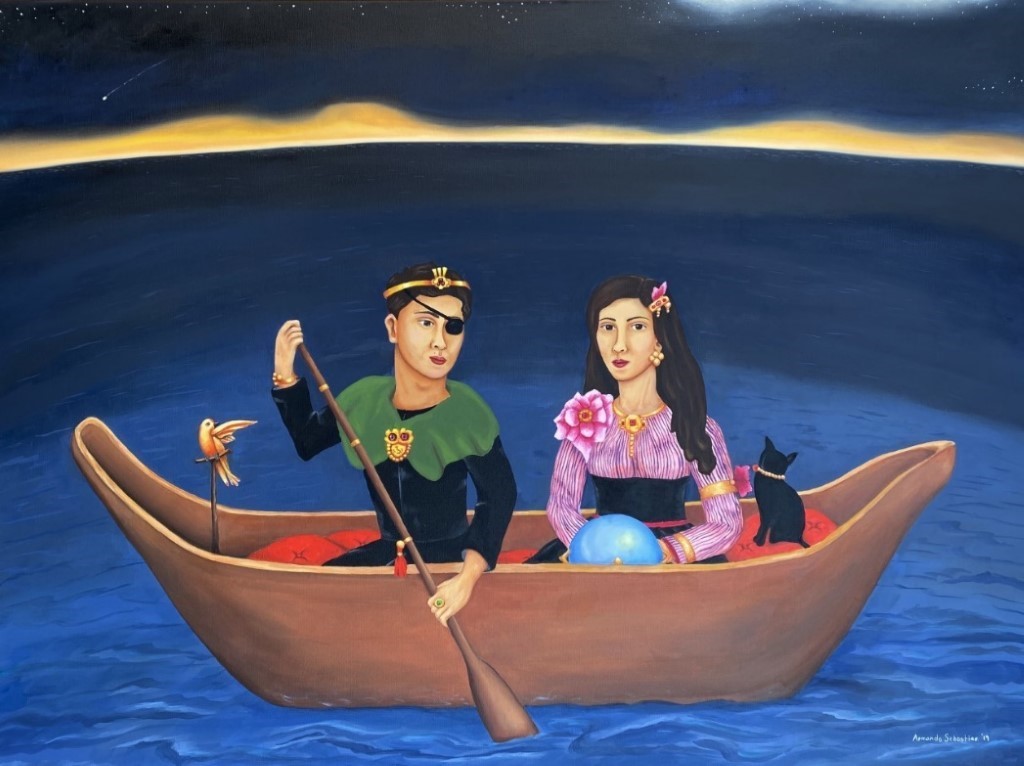We reached out to Break Bread, Break Borders, one of our community partners for the My|gration exhibition, and invited them to share a favorite recipe from their kitchen, as well as provide some background on their organization. Follow these steps to learn how to make a Syrian-style chicken kabsa dish, and find out more about this local nonprofit that “caters with a cause” in their message below.
Chicken Kabsa: Syrian Style (feeds 4 people)

Ingredients:
- 2 cups basmati rice
- 1 whole chicken cut into pieces or 4 thighs
- 1 medium size onion
- 5 pieces of minced garlic
- 1 green pepper
- 2 green chili peppers
- 1 cup grated carrots
- 1 cup tomato sauce
- Handful of raisins (can skip)
- Nuts (almonds) for decoration (can skip)
Spices and herbs:
- Salt
- Black pepper
- Juice of 1 lime
- 2 cinnamon sticks
- 2 bay leaves
- 3 cloves
- 5 cardamom pods
- 1 teaspoon of “7 Spices” mix
- 1 teaspoon kabsa spice mix
- 1 teaspoon ground ginger powder
- Parsley for garnish (optional)

Preparation:
- Chop onions and pepper finely
- Add oil in pot
- Add onions first; when it turns a bit brown, add garlic
- Add the rest of the veggies and mix
- Add tomato sauce
- Add salt and all spices
- Lower heat and let it cook for about 5 minutes
- Add washed chicken pieces to the mix
- Mix for a little bit and then add water until chicken is covered
- Let it cook and boil until chicken is fully cooked
- Wash rice very well
- Put rice in a pot; add the chicken stock to the rice (for every cup of rice, add a cup and a half of the chicken stock)
- Let it boil and then lower heat under it
- Add some raisins to the rice 7-10 min before it’s fully cooked
- Don’t mix the raisins, only cover the rice and let it cook
- Bake chicken in the oven at 275 degrees for 15-20 minutes or until golden brown
- Roast nuts in pan until golden brown
- Before serving the rice, mix it lightly with a bit of ghee
- Serve rice in serving tray and add the chicken, nuts and minced parsley on top
- Enjoy!
BBBB Community Cook Rania Alahmad, serving her father’s recipe of Chicken Kabsa
June was first declared World Refugee Awareness Month in 2001. Since then, June has been a time to acknowledge the strength, courage, and perseverance of millions of refugees who live around the globe. By definition, a refugee is someone who fled his or her home and country owing to “a well-founded fear of persecution because of his/her race, religion, nationality, membership in a particular social group, or political opinion,” according to the United Nations 1951 Refugee Convention. Many refugees are in exile to escape the effects of natural or human-made disasters. These are the heroic journeys that inspired the show My|gration at the DMA, and our organization, Break Bread, Break Borders, is honored to be a participant in this community project.
Based in Dallas, Texas, Break Bread, Break Borders (BBBB) is a “catering with a cause” social enterprise, economically empowering women from war-torn countries by teaching them how to earn a living by honing their cooking and entrepreneurial skills. Professional chefs, restaurants, caterers, and culinary consultants mentor refugee women apprentices, who earn food service industry licenses and certifications. BBBB’s women also learn to share their powerful stories with diners, creating a unique cultural exchange.
Jin-Ya Huang founded Break Bread, Break Borders in 2017 to honor the legacy of her late mother—chef, restaurateur, and community leader Margaret Huang. Through food, culture, and powerful storytelling, we break bread with the community, breaking down borders at the same time.
BBBB has served more than 10,000 people, catering events for clients including the City of Dallas, Texas Women’s Foundation, George W. Bush Institute, Texas Lyceum, Toyota of North America, United Way of Metropolitan Dallas, Social Venture Partners-Dallas, and many more. We have been named among Dallas’s Top 50 Most Innovative Social Enterprises by Dallas Innovates. BBBB is part of a cohort of social enterprises at The Hunt Institute at Southern Methodist University. Airbnb International has featured BBBB as a social impact experience partner. Our founder Jin-Ya Huang was selected as a 2019 Food Leader of the Year by Slow Food USA. In 2020 Huang was selected for the prestigious Presidential Leadership Scholars Program, allowing her the chance to work with former presidents George W. Bush and Bill Clinton on community projects to create lasting social change.
Standing on the side of freedom, Break Bread, Break Borders proudly educates on the ideas of equity, anti-racism, and eradication of xenophobia. One bite at a time, we will continue to share the taste of hope, compassion, and transformation to the world. Enclosed here is a recipe from one of our BBBB Community Cooks, Rania Alahmad. Please enjoy her Chicken Kabsa Syrian Style with your families, neighbors, and loved ones. Happy cooking, y’all!
Jin-Ya Huang is the founder of Break Bread, Break Borders, a social enterprise developing a culinary training program to help refugee women from war-torn countries find food service job opportunities by sharing their storytelling through food and culture. She is a member of Orchid Giving Circle and a fellow of the 2020/21 Presidential Leadership Scholars Program.













